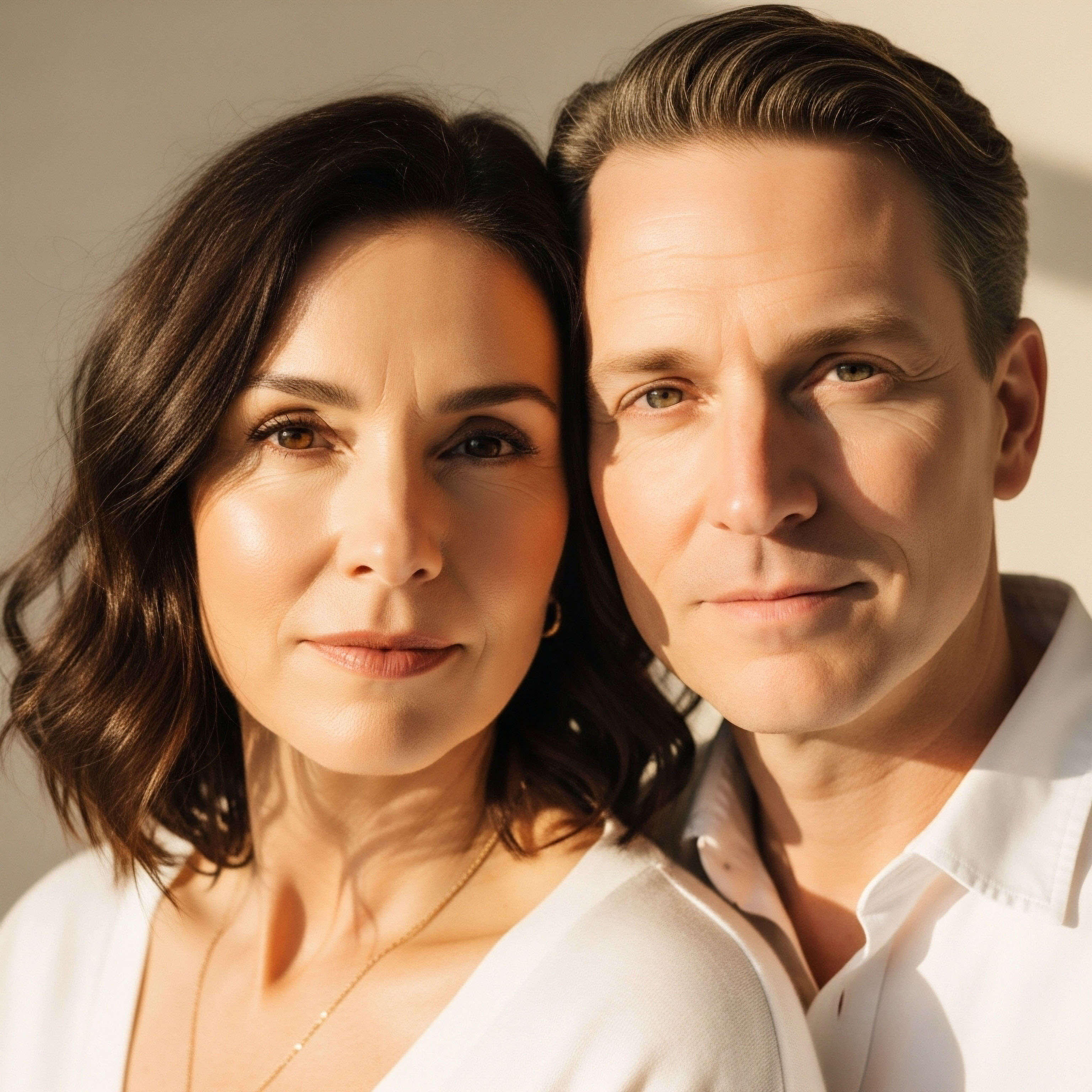

Fundamentals
The decision to begin a journey of hormonal optimization is deeply personal, often born from a quiet awareness that your body’s internal symphony has fallen out of tune. You may feel a pervasive fatigue that sleep does not resolve, a mental fog that clouds your focus, or a frustrating decline in vitality.
These experiences are valid and real. When you choose to address these symptoms with testosterone replacement therapy (TRT), you are taking a definitive step toward reclaiming your biological function. This path, however, requires a clear understanding of its implications, particularly concerning fertility.
The introduction of exogenous testosterone sends a powerful signal to your body’s command center, the hypothalamic-pituitary-gonadal (HPG) axis, to pause its own production of this vital hormone. This action quiets the orchestra, so to speak, leading to a temporary and reversible cessation of sperm production, a state known as azoospermia or severe oligozoospermia.
Understanding this process is the first step in navigating the path back to fertility. The body, in its remarkable wisdom, possesses the capacity to restart its own production with the right support. The question of long-term success in regaining fertility post-TRT is one of timelines and biological individuality.
For many men, the return of sperm production is a predictable and achievable outcome. The process is a biological recalibration, a gentle reawakening of a dormant system. The journey back to fertility is a testament to the body’s resilience and its innate drive to function as a complete, interconnected system.
It is a process that can be guided and supported by protocols designed to restore the natural hormonal cascade, ensuring that the decision to optimize your health in the present does not foreclose the possibility of building a family in the future.
The journey back to fertility after testosterone therapy is a process of reawakening the body’s natural hormonal signaling pathways.

The Body’s Internal Signaling System
Your endocrine system operates as a sophisticated communication network. The hypothalamus, located in the brain, acts as the mission control, sending signals in the form of gonadotropin-releasing hormone (GnRH) to the pituitary gland. The pituitary, in turn, releases two key messenger hormones ∞ luteinizing hormone (LH) and follicle-stimulating hormone (FSH).
LH travels to the Leydig cells in the testes, instructing them to produce testosterone. FSH signals the Sertoli cells, also in the testes, to support sperm maturation. This elegant feedback loop ensures a steady supply of both testosterone and sperm.
When you introduce testosterone from an external source, the hypothalamus senses an abundance of the hormone and ceases its GnRH signals. This, in turn, shuts down the pituitary’s release of LH and FSH, leading to a halt in both testosterone and sperm production within the testes.
The goal of a post-TRT fertility protocol is to gently and effectively restart this entire cascade. It involves using specific medications to mimic the body’s natural signals, encouraging the pituitary to once again release LH and FSH, and thereby reawakening the testes.
This process is a clinical application of our understanding of human physiology, a way to work with the body’s own systems to restore their inherent function. The success of this recalibration hinges on several factors, including the duration of your TRT protocol, your age, and your baseline fertility status before beginning therapy. For most men, this restoration is a matter of when, not if, and it underscores the profound adaptability of the human body.


Intermediate
For those who have engaged with hormonal optimization protocols, the conversation around fertility post-TRT moves from the conceptual to the practical. It becomes a matter of clinical strategy, timelines, and the specific agents used to restore the intricate functionality of the hypothalamic-pituitary-gonadal (HPG) axis.
The suppression of spermatogenesis via exogenous testosterone is a predictable physiological response. The subsequent restoration of that function is a well-understood process, guided by protocols designed to mimic and amplify the body’s endogenous signaling mechanisms. The success rates are encouraging, with a majority of men achieving a return of sperm to the ejaculate within a defined timeframe. This process, however, is not a simple switch; it is a biological recalibration that is influenced by individual factors.
The duration of testosterone therapy and a man’s age are significant predictors of the time required for sperm recovery. Longer exposure to exogenous testosterone can lead to a more profound suppression of the HPG axis, requiring a more extended period of recovery. Similarly, age can influence the responsiveness of the testes to stimulation.
The clinical protocols employed are designed to address this suppression directly, using agents that stimulate the pituitary gland and provide the necessary hormonal precursors for spermatogenesis. These protocols are a testament to our ability to translate a deep understanding of endocrinology into effective clinical action, offering a clear path back to fertility for those who have chosen to optimize their hormonal health.
Clinical protocols for fertility restoration post-TRT are designed to systematically reactivate the body’s natural sperm production signals.

Protocols for Restoring Spermatogenesis
The primary goal of a post-TRT fertility protocol is to re-establish the pulsatile release of LH and FSH from the pituitary gland. This is typically achieved through the use of selective estrogen receptor modulators (SERMs) and human chorionic gonadotropin (hCG). These agents work through distinct yet complementary mechanisms to restart the body’s natural testosterone and sperm production.
- Human Chorionic Gonadotropin (hCG) This molecule is structurally similar to LH and binds to the same receptors on the Leydig cells in the testes. Its administration effectively mimics the action of LH, stimulating the testes to produce testosterone. This intratesticular testosterone is crucial for spermatogenesis. hCG is often a cornerstone of fertility restoration protocols, providing a direct signal to the testes to resume function.
- Selective Estrogen Receptor Modulators (SERMs) Medications like Clomiphene Citrate (Clomid) and Tamoxifen work at the level of the hypothalamus and pituitary gland. They block estrogen receptors, tricking the brain into perceiving a low estrogen state. Since estrogen is part of the negative feedback loop that suppresses GnRH, blocking its effects leads to an increase in GnRH production, which in turn stimulates the pituitary to release more LH and FSH. This dual action of boosting both LH and FSH makes SERMs a powerful tool for restarting the entire HPG axis.
- Aromatase Inhibitors (AIs) In some cases, an Aromatase Inhibitor like Anastrozole may be used. These medications block the conversion of testosterone to estrogen. By lowering systemic estrogen levels, they can reduce the negative feedback on the hypothalamus and pituitary, further enhancing the release of LH and FSH.

What Are the Expected Timelines for Sperm Recovery?
The timeline for the return of spermatogenesis after ceasing TRT is a critical aspect of managing expectations. Clinical data provides a clear framework for these timelines, though individual responses can vary. A pooled analysis of multiple studies offers a probabilistic view of sperm recovery:
| Time Since Cessation | Probability of Sperm Recovery |
|---|---|
| 6 Months | Approximately 67% |
| 12 Months | Approximately 90% |
| 16 Months | Approximately 96% |
| 24 Months | Nearly 100% |
These figures represent the likelihood of recovering a sperm concentration of over 20 million sperm per milliliter, a standard benchmark for fertility. It is important to note that these are statistical averages, and the journey for an individual may be shorter or longer.
Factors such as the specific type of testosterone used, baseline sperm parameters before therapy, and adherence to the recovery protocol all play a role in the timeline. For many, the use of a structured recovery protocol featuring hCG and SERMs can accelerate this process, offering a more proactive approach to restoring fertility.


Academic
A sophisticated analysis of post-TRT fertility moves beyond simple success rates and into the intricate molecular and cellular dynamics of the hypothalamic-pituitary-gonadal (HPG) axis. The administration of exogenous androgens induces a state of secondary hypogonadotropic hypogonadism, a condition characterized by the suppression of gonadotropin secretion from the pituitary gland.
This suppression is the direct result of negative feedback exerted by elevated androgen levels on the hypothalamus and pituitary. The central challenge in restoring fertility is to overcome this induced quiescence and re-establish the endogenous pulsatile secretion of GnRH, LH, and FSH that orchestrates spermatogenesis. The long-term success of this endeavor is predicated on the inherent plasticity of the HPG axis and the targeted pharmacological interventions that can modulate its function.
The scientific literature provides robust evidence for the efficacy of various protocols in restoring spermatogenesis. These protocols are grounded in a deep understanding of endocrine physiology, leveraging agents that can either mimic endogenous gonadotropins or modulate the feedback mechanisms that govern their release.
The choice of protocol, the duration of treatment, and the ultimate success are influenced by a constellation of factors, including the patient’s age, the duration and type of androgen exposure, and baseline testicular function. An academic exploration of this topic requires a granular examination of the mechanisms of action of these therapeutic agents and the clinical data that substantiates their use.
The restoration of fertility post-androgen-induced hypogonadism is a clinical exercise in reactivating the complex neuroendocrine machinery of the HPG axis.

Pharmacological Interventions and Their Mechanisms
The restoration of spermatogenesis post-TRT is a process of pharmacological intervention designed to restart a temporarily dormant biological system. The primary agents employed are human chorionic gonadotropin (hCG) and selective estrogen receptor modulators (SERMs), often used in combination to achieve a synergistic effect.

Human Chorionic Gonadotropin (hCG)
hCG is a glycoprotein hormone that shares a common alpha subunit with LH, TSH, and FSH, and a beta subunit that confers its biological specificity. Its structural homology with LH allows it to bind to and activate the LH receptor on testicular Leydig cells.
This activation stimulates the production of intratesticular testosterone (ITT), a prerequisite for the initiation and maintenance of spermatogenesis. The concentration of testosterone within the testes is many times higher than in the peripheral circulation, and this high local concentration is essential for the proper maturation of sperm.
The use of hCG effectively bypasses the suppressed hypothalamus and pituitary, directly stimulating the testes to resume testosterone production. Clinical studies have demonstrated that hCG monotherapy can restore spermatogenesis in a significant portion of men with androgen-induced infertility.

Selective Estrogen Receptor Modulators (SERMs)
SERMs, such as clomiphene citrate and tamoxifen, exert their effects at the level of the central nervous system. These agents are competitive antagonists of the estrogen receptor in the hypothalamus. By blocking the negative feedback effect of estrogen, they lead to an increase in the pulse frequency and amplitude of GnRH secretion.
This, in turn, stimulates the anterior pituitary to increase its secretion of both LH and FSH. The elevated LH levels further stimulate Leydig cell testosterone production, while the rise in FSH is critical for its action on Sertoli cells, which are essential for nurturing developing sperm cells. The combined effect is a comprehensive reactivation of the entire HPG axis, from the hypothalamus down to the testes.

What Factors Predict the Success of Fertility Restoration?
The probability and timeline of successful spermatogenesis recovery are not uniform across all individuals. Several key factors have been identified in clinical research that predict the likelihood of a positive outcome.
| Factor | Influence on Fertility Recovery |
|---|---|
| Duration of TRT | Longer duration of therapy is associated with a longer time to sperm recovery. |
| Age | Increased age can be a predictor of a longer recovery period. |
| Baseline Testicular Volume | Larger baseline testicular volume is often a positive predictor of success. |
| Previous Androgen Exposure | Prior use of anabolic-androgenic steroids may prolong recovery time. |
| Azoospermia vs. Cryptozoospermia | Men with cryptozoospermia (very low sperm count) at the start of recovery tend to recover faster than those with azoospermia (no sperm). |

The Role of FSH in Spermatogenesis
While hCG can effectively restore intratesticular testosterone, the role of FSH is also of paramount importance. FSH acts on Sertoli cells, stimulating the production of various proteins and nutrients that are essential for the maturation of spermatids into fully functional spermatozoa.
In cases where hCG and SERM therapy alone are insufficient to restore spermatogenesis, the addition of recombinant FSH (rFSH) or human menopausal gonadotropin (hMG), which contains both FSH and LH activity, can be beneficial. This is particularly true for men with profound suppression of the HPG axis or those with a history of anabolic steroid use.
The combined administration of hCG and FSH/hMG provides a more complete physiological signal to the testes, addressing both the Leydig and Sertoli cell compartments and maximizing the potential for a robust recovery of spermatogenesis.

References
- Ramasamy, R. et al. “Age and Duration of Testosterone Therapy Predict Time to Return of Sperm Count after hCG Therapy.” Journal of Urology, vol. 197, no. 4, 2017, pp. e635-e636.
- Wheeler, K. M. et al. “Recovery of spermatogenesis following testosterone replacement therapy or anabolic-androgenic steroid use.” Asian Journal of Andrology, vol. 18, no. 2, 2016, pp. 233-238.
- Wenker, E. P. et al. “The Use of HCG-Based Combination Therapy for Recovery of Spermatogenesis after Testosterone Use.” The Journal of Sexual Medicine, vol. 12, no. 6, 2015, pp. 1334-1337.
- Liu, P. Y. et al. “The rate, extent, and modifiers of spermatogenic recovery after hormonal contraception in men.” The Lancet, vol. 363, no. 9416, 2004, pp. 1415-1423.
- Bouloux, P-M. G. et al. “Induction of spermatogenesis by recombinant human follicle-stimulating hormone (follitropin alfa) in hypogonadotropic hypogonadal men.” Fertility and Sterility, vol. 77, no. 2, 2002, pp. 270-276.

Reflection
The journey through hormonal optimization and the subsequent path to restoring fertility is a profound education in your own biology. The information presented here, from the fundamental principles of endocrine function to the specifics of clinical protocols, provides a map. It illuminates the pathways and processes that govern a vital aspect of your health.
This knowledge is empowering, as it transforms uncertainty into understanding. It allows you to see your body not as a fixed entity, but as a dynamic, adaptable system that responds to targeted inputs.
This understanding is the starting point. Your personal health narrative is unique, written in the language of your own physiology, experiences, and goals. The decision to build a family, now or in the future, is a deeply personal one. The science of fertility restoration provides the tools, but the application of those tools is a collaborative process.
Consider this knowledge a foundation upon which to build a proactive and informed conversation with a clinical expert who can help you navigate your specific circumstances. The potential to harmonize your immediate well-being with your future aspirations is within reach, and it begins with the decision to understand the intricate and remarkable system that is your own body.



